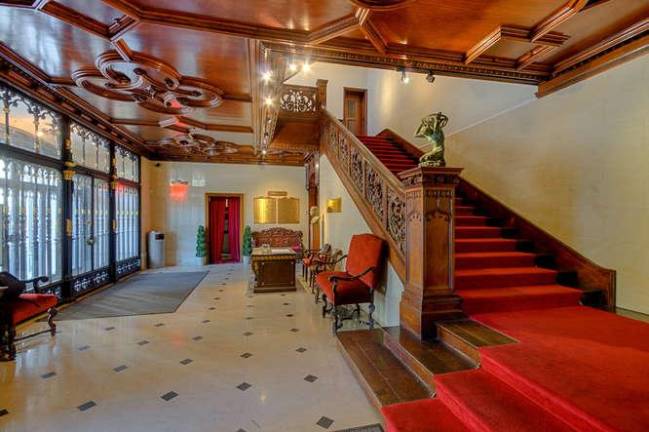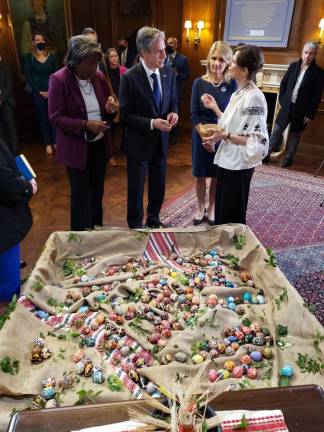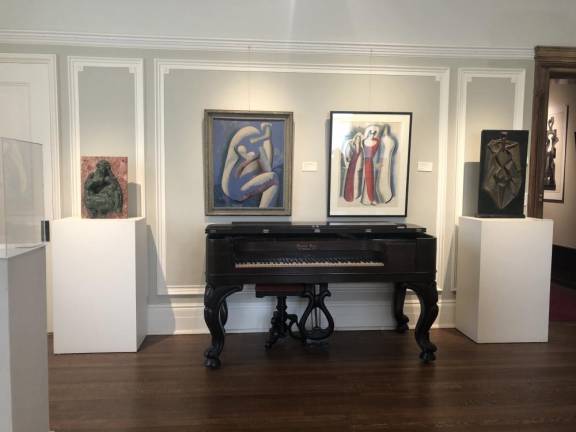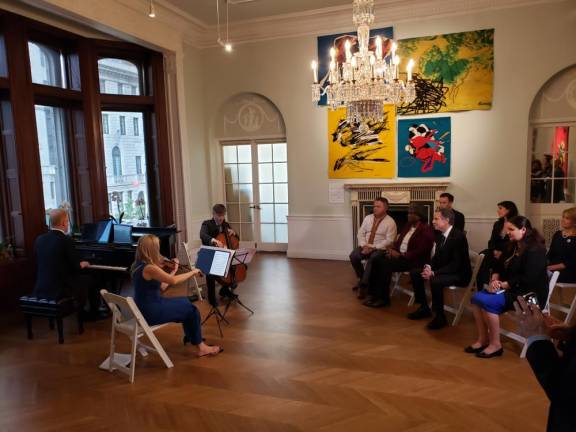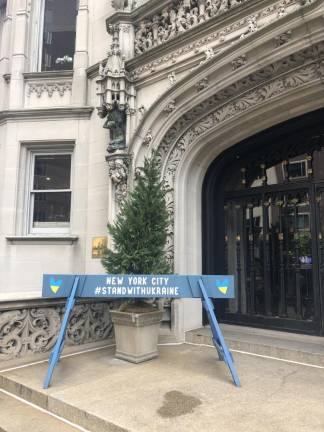Minding the Heritage
The Ukrainian Institute of America is one of the city’s many small-scale cultural treasures that may not be on your radar – but should be
It was late in the afternoon on Thursday, May 19, and a small cadre of journalists was huddled in the lobby of the Ukrainian Institute of America on Museum Mile, before being ushered up to the second floor of the Gilded Age mansion. They were awaiting the arrival of Secretary of State Antony Blinken and his entourage, which on this day included the Ukrainian Ambassador to the U.S., Oksana Markarova, and the U.S. Ambassador to the United Nations, Linda Thomas-Greenfield.
When Blinken and his party arrived, they were treated to a mini-concert featuring a selection from Ukrainian composer Vasyl Barvinsky’s “Piano Trio in A Minor,” performed by Solomiya Ivakhiv (violin), a Ukrainian-American who introduced the piece, along with Steven Beck (piano) and Darrett Adkins (cello).
A private tour for the dignitaries of the French Gothic building ensued, followed by a meeting with Ukrainian-American pysanka (Ukrainian Easter egg) artist Sofika Zielyk. She encouraged Blinken and his colleagues to choose an egg from a bowl of decorative pysanky (plural of pysanka), and add one to the mix arrayed in a box on the floor, part of an installation resembling a shrine assembled after Russia’s invasion of Ukraine in February.
The pysanky boasted traditional designs from areas of Ukraine that have been most affected by the war, the motifs symbolically representing strength, health and rebirth.
“We had an opportunity to hear some extraordinary music, to see some extraordinary art, and also to take in this remarkable collection that represents so much,” Blinken said as he stood before the display. “It represents through these eggs hope for the future and Ukraine’s rebirth as it emerges from the aggression being committed against it by Russia.”
“The Eggs Are Coming In”
“The Pysanka: A Symbol of Hope” is a project dreamed up by Zielyk in collaboration with the Institute and the World Federation of Ukrainian Women’s Organizations. It’s a “communal and participatory exhibition” with a DIY spirit that seeks contributions of traditional hand-decorated Ukrainian eggs from adults and children alike.
More than 300 eggs have thus far been collected, arriving from virtually every state in the U.S. “The eggs are coming in every day. This is worldwide,” Zielyk told Our Town in an interview. “The eggs are coming in from Europe, from South America ...We are asking for traditional egg designs because this is a very traditional, primeval, cultural project.”
The goal is to someday bring the highly ornamented pysanky to Ukraine “to symbolically help with the rebirth of a nation because these eggs were a symbol of rebirth,” Zielyk said.
“We will go to areas that were affected by the war, and we will bury eggshells in gardens, we will put a few in cattle feed, we will sprinkle them everywhere as our ancestors did,” she said. “People will be physically building Ukraine back, and we will be symbolically doing that, just as our ancestors did thousands of years ago. They truly believed the eggshells with these symbolic designs had magical powers.”
Attendance at UIA has shot up since the invasion last winter. “At the outbreak of the war, we saw a five-fold increase in visitors to the Institute. This has leveled off a bit, but we are grateful to still have around triple the usual number of visitors to our galleries,” Interim Director Lydia Zaininger stated in an email.
Fine Art Collection
Unbeknownst to many New Yorkers, the Institute is not only the keeper of folk art and native traditions, but also home to an impressive collection of fine art that includes a small room on the fourth floor dedicated to works by Cubist sculptor and painter Alexander Archipenko, a Ukrainian-American.
In addition, there is a robust program of temporary shows, notably the new survey, “Antiquitas Nova,” featuring Lviv-based Ukrainian artists Oleh and Alexander Denysenko’s imaginary sculptures, prints and paintings.
A nonprofit founded in 1948 with a mission to promote Ukrainian arts, culture and history, the Institute has a wealth of programming that extends beyond folk art and fine art to include concerts, film screenings, poetry readings, literary events and lectures.
But perhaps its biggest draw — and its prized possession — is the late 19th century C.P.H. Gilbert-designed building itself, the Fletcher-Sinclair mansion at the southeast corner of 79th Street and Fifth Avenue, with turrets, gargoyles and griffins on the outside, and carved woodwork, chandeliers and marble fireplaces galore on the inside.
Inventor-industrialist William Dzus, the Institute’s founder, purchased the mansion in 1955 for UIA, following the death of its final private owner, Augustus Van Horne Stuyvesant, Jr., the last direct descendent of Peter Stuyvesant.
Secretary of State Blinken spoke movingly of the Institute’s mission during his visit:
“One of the things that President Putin’s war is trying to accomplish is to somehow erase Ukrainian identity. That identity is manifested through its culture, the culture that we’ve been able to experience a small piece of today. And the vibrancy of that culture, the strength of that identity, makes it crystal clear that there again, President Putin’s war will not succeed.
“This place is a remarkable affirmation of Ukraine’s culture, its heritage, its history, its identity. And it’s a living culture, identity, and one that I am very pleased and proud to have had an opportunity to experience today.”
Ukrainian Institute of America, 2 East 79th Street (at Fifth Avenue); check the website before visiting:
